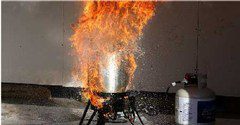Holiday Hazards
No matter what climate you live in or what time of year it is, storms are inevitable. And, the unfortunate fact is, where there are storms, there is storm damage. Storms can cause a huge variety of damage to a property, both exteriorly and interiorly.

Risks and Prevention
Three of the biggest holiday risks for structural fires are deep fried turkeys, burning candles, and Christmas trees. Knowing all safety precautions to take to try may mitigate or eliminate the risk of fire at this time of year.
Fried Turkeys
Fried turkey fires cause an estimated $15 million in damages each year. There are three major missteps usually made leading to these devastating fires. Not thawing the bird properly, not turning the flame off before dipping the turkey, and overfilling with oil are the main risks. According to the National Fire Protection Association, Thanksgiving is the peak day in the United States for home cooking fires in general. It’s important to always monitor any cooking in the home, and, if deep frying a turkey, to ensure that the deep fryer is an appropriate distance from any structure.
Candles
The top three days for fires caused by candles in the United States are Christmas Eve, Christmas Day, and New Years Day. Two-fifths of home decoration structure fires are started from candles, with over half of those occurring in December. To mitigate the risk of candle fires, it’s crucial to keep candles at least twelve inches away from anything flammable and to keep them in a stable holder where they won’t be knocked down. To eliminate the risk entirely, electric, flameless candles have come a long way and look and smell more realistic more and more as the flameless candle industry grows.
Christmas Trees
One-quarter of Christmas tree fires are caused by electrical problems and another quarter are caused by a heat source too close to the tree. These types of fires are typically very, very serious. It’s extremely vital to take all precautions necessary to prevent Christmas tree fires. Any heat source should be a minimum of three feet from the tree, and further, if possible. It’s necessary to read and follow all manufacturer’s instructions for lights on the tree as well as to inspect all lights that have been used in previous years to make sure they aren’t damaged. If it’s a real tree, it must be watered every day and removed from the home as soon as it’s dry.
What Next?
Even the best-laid plans sometimes fail, and no amount of prevention can save the day. Once the flames are gone and the smoke has cleared, it’s time to clean up. There are a lot of different things to consider in the wake of a structural fire.
Board Ups
Often it’s necessary to utilize emergency board up services after a fire. Fires can cause holes in exterior walls in a variety of ways, including burnt walls and blown-out windows or doors.
Insurance
Once the fire is out and the home boarded up, it’s important to contact your insurance company if you haven’t already. With fire damage, it’s a good idea to make sure the insurance and restoration company are on the same page and agree with the scope of work. The last thing you want when trying to recover from a fire is for your insurance company to come back and let you know that the work isn’t covered.
Dry Out
Most people don’t think of water damage after they’ve experienced a fire loss, but it’s often an issue for several reasons, including firefighting efforts, damage to plumbing, and rain or snow entering the home after the damage. It’s necessary to get the home properly dried in these cases so that cleanup can continue.
Contents
The contents of the home, which are basically all your belongings, need to be packed out, inventoried, and properly cleaned so that cleaning and repair of the structure can occur. Even if the contents were not directly affected by the flames, soot and smoke causes damage that is sometimes beyond cleaning and repair. It’s important to keep meticulous inventory records for this reason.
Cleaning and Deodorizing
Again, soot and smoke can cause damage to the home beyond that caused by the actual fire. Any material in the home affected but not removed needs to be thoroughly cleared of soot and other residues as well as deodorized. There are a vast number of ways to handle this, depending on the type of fire and the company doing the cleaning.
Repairs
Once mitigation is complete, repairs can begin. This step is another point in the process where it’s crucial to ensure the restoration contractor and insurance company are communicating and agree on the scope of work to avoid any delays. This final step is what will return your home to pre-loss conditions in the event of a fire.
A house fire is devastating at any time, but experiencing one around the holidays only adds insult to injury. It’s important to know the proper precautions to take to prevent fires at this time of year, as well as the steps to take if you do experience fire damage.








